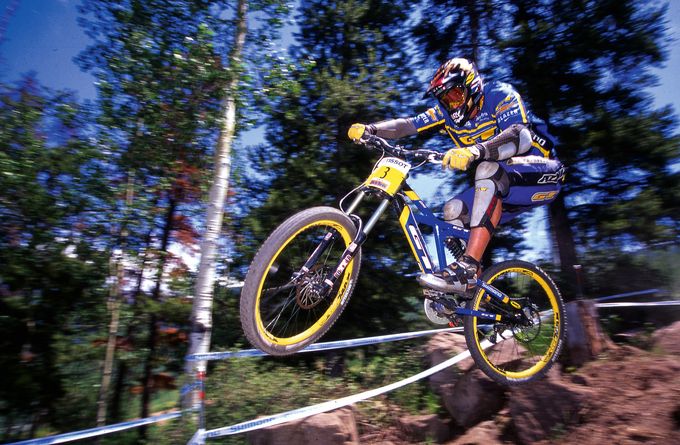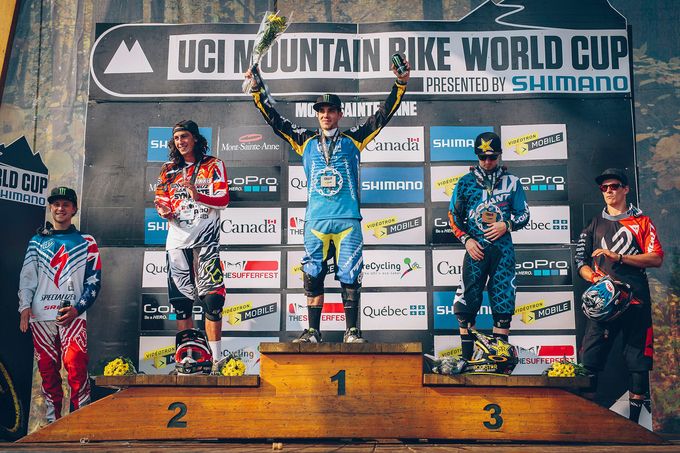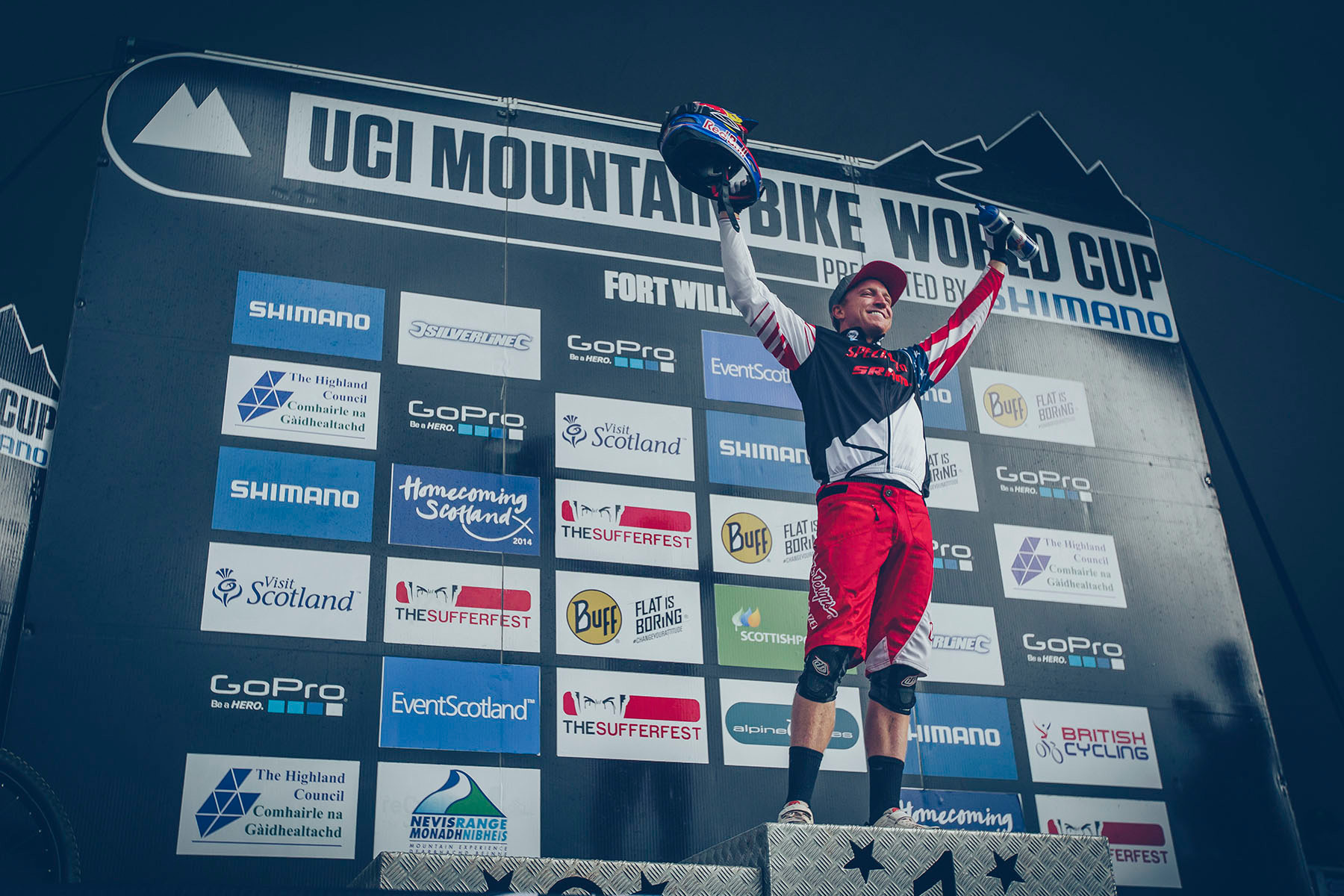
IS IT HARDER TO WIN A WORLD CUP DOWNHILL THAN EVER BEFORE?
An investigation into the podiums, places, times and faces of the past two decades of men’s world cup downhill racing shows the times getting closer but the number of winners getting less
Anyone who witnessed the cliff-hanger at Meribel world cup last year will tell you that downhill racing has never been so close, demanding unheard of levels of precision and calculation, that there is no longer room for mistakes in tyre choice, suspension set up, bike size, tyre pressure, clothing tightness or diet. Some riders have even been heard to say they are not allowed to stand up too much in the run-up to a race.
But whilst this is all might seem very uptight, in your face even, the memories of
the 2014 World Cup season were of a racer seemingly not giving too shits, getting on a roll, enjoying himself and carting off the title in the back of his Transit van. It’s hard but only if you try TOO hard. Maybe, but it took Josh many seasons to attain his first victory. Winning a world cup has never been easy, but let’s have a look at the facts.
Its often thought that there were more races during the early years of downhill which might suggest there were more chances of winning. The reality however is that over the past decade (2005 – 2014) there have been 67 races and the decade before that (1995 -2004) there were 66 world cups. True from ’98 to ’01 there were eight races each year, and such a varied season has only happened twice in the past decade – 2009 when Sam Hill won an eight round epic, and before that in 2005 when Minnaar took the series on the Honda.
For the record in the men’s world cup class there have been 145 races and 41 individual winners.
PODIUM DIFFERENTIAL
A good indicator of how difficult it is to win a world cup is the amount of time separating first and fifth for those podium places. The early decade of the sport from 1997 to 2005 shows pretty large time gaps but from 2005 onwards the podium is on average split by about three to five seconds and the trend from 2008 onwards is a contraction of time for podium positions, only in 2011 was there a slight rise in this.
Prior to 2005, in the first twelve years of racing, podium times were separated by on average about five to eight seconds. There were some anomalies to this – 2000 was particularly tight when the wet and windy Leysin is taken out of the skew, making the average closer to about 3.5 seconds for the season. 2003 was also a close season, about 2.6 seconds, but then that was a crazy year on many counts. It was also the only season apart from 1995 when there was a different winner at each race and where the average track times for the year were at an all time low of 2.8 minutes.
Indeed track times in the first ten years of racing were considerably higher than what they are today with averages of up to five minutes being common compared to todays average which is closer to three and a half minutes. This clearly affects how close those podium spaces are separated so its no real surprise that there appears to be a direct correlation between podium times and track length.
Average time between first and fifth place 2005 – 2014
97 – 4.5 06 – 3.0
98 – 7.6 07 – 3.41
99 – 8.5 08 – 5.85
00 – 5.6 09 – 4.8
01 – 6.5 10 – 4.2
02 – 7.6 11 – 5.1
03 – 2.6 12 – 4.14
04 – 5.5 13 – 3.3
05 – 7.2 14 – 3.0
Contracting podium times certainly appears to be a trend that seems to have continued particularly in recent years suggesting things are indeed getting tighter at the top. But it also hides events that counter such a theory. There have been seasons in which the racing was equally as tight as today. 2006 in fact matched last year for compressed podium space, with only two to three seconds between first and fifth for much of the year. Even that was skewed massively by Sam Hill’s seven second Schladming demolition which raised the average times. A few years later, 2008 was a different story, a pretty slack year where the podium spaces appeared to widen – almost six seconds for the season, double what it was last year. This was the year Minnaar podiumed every single race, a feat matched only by Vouilloz (98), Minnaar again (05) Atherton (10) Gwin (11) Smith (13).
Mt Saint Anne
When you look with more depth into particular races the picture is very complex due to the transient nature of the locations hosting races. But Mt Sainte Anne (MSA) has been a constant and could be indicative of what’s been happening.

MSA backs up the theory that races are becoming increasingly tough and also substantiates the fact that 06 was at odds with what was happening and that 2008 did in fact begin a change in trends which we saw on the previous table of seasonal differentials. 2006 yet again proved one of the tightest podium margins ever at this event – 2.66 seconds and has only ever been closer once, last year at 2.14 seconds, and that 2008 was certainly the year which started a trend, at MSA at least, of declining times in both the podium, top ten and top twenty places. This peaked last year to record low margins suggesting that yes winning has become more difficult.
Yet in as much as MSA might well be a good indicator the overall picture however, although random events have regularly skewed the story, be it wet weather, a xen run or punctures, paints a pretty constant but less than polished picture, and that the time difference between first and fifth place on world cup podiums has not really changed much for the past twenty years and has fluctuated between three and eight seconds during that time scale. There are several things to consider however.

TRACKS AND TIMES
As mentioned earlier, track times up to the turn of the century were consistently around four to five minutes in duration compared to the past decade in which track times have averaged around the three and a half minute marker. Fort William is one of the few races that gets close to five minutes these days and the last two seasons have been won on 4minutes 36 seconds. Other than the Aonoch Mor man made track, only Mt St Anne and Schladming have consistently put times over the four minute mark.
Even though the track times were on average slightly higher during the late nineties with average times over the four minute mark, which pushed the podium differential times up slightly, it wasn’t by much. Consider the fact that during 1997 when Italian Corado Herin won the series, the average time differential between first and fifth was 4.5 seconds on average track times of 4.5 minutes. Only six times this century has the average podium time been lower than that. In that respect you cannot say that racing has become harder.
Tracks have been around three and a half minutes on average for the last ten years now, that’s about a minute less than the late nineties average. When you consider this drop this only strengthens the argument that racing has not in fact got tighter because the racers on the longer tracks of the nineties got equally close podium times. However that does mean that on the shorter tracks of today that there is less room for mistakes and less time to make the time back up. The nature of tracks has also changed.
These changes to the nature and speed of tracks might have played a major part in the difficulty of winning a world cup however. Tracks are now more open and faster although it’s incredibly difficult to get some hard facts on the exact amount of speed change that has taken place.
Wet weather will clearly affect the average podium winning margins so too will a rider producing a run form another dimension. Herin, Vouilloz, Gracia, Peaty, Kovarik, Hill, Gwin are the only riders to have wins over five seconds, and done largely on technical or wet track conditions. There have been less big wins in the past decade than in the history of racing. Gwin’s eight second Val Di Sole demolition in 2012 being the biggest in recent history. Those are the races impossible to win.
THE BIGGEST WINNING MARGINS 1997- 2014

PODIUM TRAFFIC
Even though the trend suggests a tightening of time on the podium remember this also happened during the 2006 season. Maybe one of the more telling facts is that there are also more riders visiting the podium during the season in recent years suggesting more riders taking risk to get there, its most likely that there’s a stronger depth of talent in racing at the minute who also happen to have access to equipment and information necessary to get a chance.
Number of riders visiting the podium 2006 – 2014
2006 – 11 2010 – 14
2007 – 11 2011 – 13
2008 – 10 2012 – 13
2009 – 10 2013 – 14
2014 – 14
RACING HAS ALWAYS BEEN CLOSE
History shows that racing has always been close. In Cortina in 2000 Vouilloz won on 3:16.09 with fifth place podium Cedric Gracia on 3:17.29, a total of 1.2 seconds. In Meribel last season Sam Hill won on 3:16.37 with Atherton fifth on 3:17.45 making a 1.1 second podium differential. There have been many others over time, below are some classic examples.
Examples of time differences between 1st to 5th place

Nevertheless there does seem to be a narrowing of the margins for error. As mentioned earlier the podium times have got less in five of the past six seasons. This has never happened before for such an extended period. Let’s take a look in more detail at the past seven seasons.
2014 which witnessed the tightest margins ever with an average of 3 seconds separating the podium spaces over the season, was raced on tracks with similar times as they have been for a decade. The last four years have seen consistently lower podium differential times year on year. The important fact here however is that only eight times in the past 33 races (five seasons) has the podium differential ever been more than five seconds. Before that (05-09 seasons) 22 out of 34 races had race podiums with a five second difference or more.
Remembering that this is raced on about the same average track times then this backs up the theory that yes, it actually might have got more difficult to get to the top. Fifteen of the past 33 podiums have been around the three-second mark. There have also been more 1-2 second podium differentials than ever before over such a short period.
However. Within those super close seasons you have to consider who was involved in the battle for the win. In the 26 races from 2010 to 2013 four racers – Greg Minnaar, Aaron Gwin, Gee Atherton and Stevie Smith won 23 of those events. What does this tell us? Probably not much. But consider the characters that have dominated the sport over time and the picture becomes a little clearer.

The chart of winners highlights many interesting facts. First of all it shows how difficult it was to win a race during a period dominated by Vouilloz and Peaty who between them won not far off half the races during that decade winning 28 of the 66 world cup events. It is a remarkable that the Frenchman and Englishman were so dominant. 41 podiums to Vouilloz (although he retired in 2002) and 29 to Peaty over the 66 races are crazy high percentages. To win a race meant getting past those two. But several did. The chart shows that in total ten riders won more than one event and a total of fourteen racers who won a world cup never to repeat the result again.
(Bear in mind that the chart does not show the two previous seasons dominated by Jurgen Beneke and Francois Gachet who cannot go without note.)

It is in the past decade that we see a major shift in racing. By this point the sport and the equipment used has matured and also settled. Bikes are now almost entirely eight inches in travel with geometry slowly settling too. The most notable statistics show that again, like in 95-05 two riders dominate. Hill and Minnaar take 27 seven of the 67 races, a feat similarly achieved by Peaty and Vouilloz. Again there are ten racers who win more than one world cup.
Unlike the previous decade there are now four racers with five or more wins, which arguably also makes it more difficult to win. The big contrast however is the fact that only 16 racers win 67 world cup events (26 in the previous decade over 66 races) and only six racers manage to win their one and only race compared with fourteen in the years 1995 -2005. Such numbers suggest that yes it has got harder to win a world cup race.
LESS CONTENDERS THAN EVER BEFORE
The changes and advancement in technology, componentry, materials and information over the lifetime of the sport has clearly had an effect on how difficult it is to win a world cup race. During the early years there was certainly a case of the have’s and the have not’s in terms of equipment. In the 90’s this mighty simply have been if you had a Michelin contract or not. The Sunn team also worked on a different dimension to other teams which is born out in the fact that it still has the record for most race wins and titles. Still, the racing was always tight as the chart below shows.

Yes the Sunn team had bike telemetry, on track split timing and custom bikes for each racer but ultimately they had Vouilloz and Chausson, who lived, breathed, thought and processed information differently. It’s arguable that their visualisation and speed of learning on new tracks would still have the same impact with today’s helmet cam’s.
In terms of bike’s there is certainly more equality around the pits than there was in the 90’s and more riders have access to similarly performing equipment even though the talk might be otherwise. In fact some of the bikes are actually quite good and some companies make production bikes capable of winning at the highest level.

In terms of fitness the game has been analysed to a point where downhiller’s are custom built athletes. Its fair to say a lot goes in to a ten races, about the average what some of the top racers compete in during the season. They also have the masseurs, mechanics and molly coddlers to keep them happy.
You could also argue the bikes, tyres, diets, clothing and strategy has become so homogenised, so copied, that nobody is actually doing anything so very different to the next team. Its easy to get the equipment and the information, its also easy to copy the riding techniques be they faster or not.
What’s less easy to find is raw riding ability coupled with an ability to apply it and make it count. There are many who believe there are now more riders capable of winning than ever before which makes it harder to win a world cup, yet the facts however say otherwise. That there is a smaller group of riders putting a squeeze on the top five, with what appears to be shrinking podium time and space. That there are in fact less riders with it in them to sit in that dirty old chair or climb those booze drenched steps to glory.


